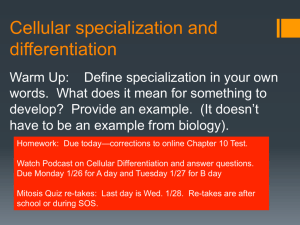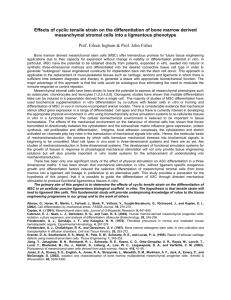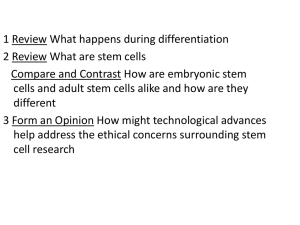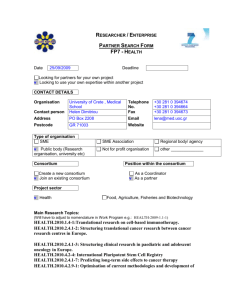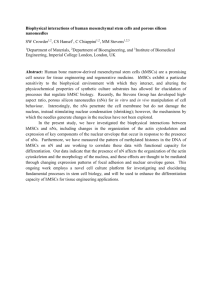Morris Trevor Morris Dr. Bert Ely Honors Genetics November 10
advertisement
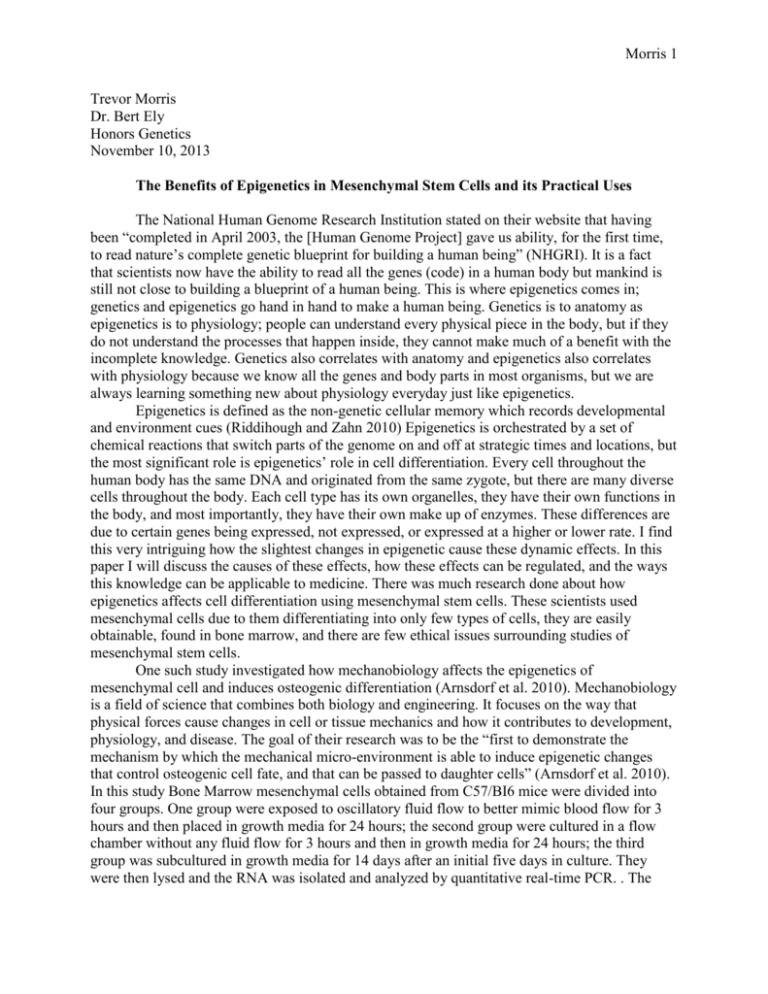
Morris 1 Trevor Morris Dr. Bert Ely Honors Genetics November 10, 2013 The Benefits of Epigenetics in Mesenchymal Stem Cells and its Practical Uses The National Human Genome Research Institution stated on their website that having been “completed in April 2003, the [Human Genome Project] gave us ability, for the first time, to read nature’s complete genetic blueprint for building a human being” (NHGRI). It is a fact that scientists now have the ability to read all the genes (code) in a human body but mankind is still not close to building a blueprint of a human being. This is where epigenetics comes in; genetics and epigenetics go hand in hand to make a human being. Genetics is to anatomy as epigenetics is to physiology; people can understand every physical piece in the body, but if they do not understand the processes that happen inside, they cannot make much of a benefit with the incomplete knowledge. Genetics also correlates with anatomy and epigenetics also correlates with physiology because we know all the genes and body parts in most organisms, but we are always learning something new about physiology everyday just like epigenetics. Epigenetics is defined as the non-genetic cellular memory which records developmental and environment cues (Riddihough and Zahn 2010) Epigenetics is orchestrated by a set of chemical reactions that switch parts of the genome on and off at strategic times and locations, but the most significant role is epigenetics’ role in cell differentiation. Every cell throughout the human body has the same DNA and originated from the same zygote, but there are many diverse cells throughout the body. Each cell type has its own organelles, they have their own functions in the body, and most importantly, they have their own make up of enzymes. These differences are due to certain genes being expressed, not expressed, or expressed at a higher or lower rate. I find this very intriguing how the slightest changes in epigenetic cause these dynamic effects. In this paper I will discuss the causes of these effects, how these effects can be regulated, and the ways this knowledge can be applicable to medicine. There was much research done about how epigenetics affects cell differentiation using mesenchymal stem cells. These scientists used mesenchymal cells due to them differentiating into only few types of cells, they are easily obtainable, found in bone marrow, and there are few ethical issues surrounding studies of mesenchymal stem cells. One such study investigated how mechanobiology affects the epigenetics of mesenchymal cell and induces osteogenic differentiation (Arnsdorf et al. 2010). Mechanobiology is a field of science that combines both biology and engineering. It focuses on the way that physical forces cause changes in cell or tissue mechanics and how it contributes to development, physiology, and disease. The goal of their research was to be the “first to demonstrate the mechanism by which the mechanical micro-environment is able to induce epigenetic changes that control osteogenic cell fate, and that can be passed to daughter cells” (Arnsdorf et al. 2010). In this study Bone Marrow mesenchymal cells obtained from C57/BI6 mice were divided into four groups. One group were exposed to oscillatory fluid flow to better mimic blood flow for 3 hours and then placed in growth media for 24 hours; the second group were cultured in a flow chamber without any fluid flow for 3 hours and then in growth media for 24 hours; the third group was subcultured in growth media for 14 days after an initial five days in culture. They were then lysed and the RNA was isolated and analyzed by quantitative real-time PCR. . The Morris 2 data was expressed as mean and standard error for Osteocalcin, Osteopontin and Collagen 1 gene expression. Osteocalcin is secreted by osteoblasts and is pro-osteoblastic, or bone-building, by nature. Osteopontin is an extracellular structural protein which is a major constituent of bone. Collagen 1 is a structural protein that helps support many connective tissues throughout the body. Arnsdorf et al. studied the three genes that code for these proteins and found the plausible locations for methylation. To determine if thses sites were methypated, the DNA was treated with bisulfite, which changes all methylated cytosine to uracil, and then running a PCR using bisulfite specific primers. The PCR showed that methylation of Osteocalcin was not affected when the mesenchymal stem cells were osteo-induced biochemically stimulated or exposed to oscillatory flow. In contrast the potential site in the Osteopontin gene was methylated and its methylation state was altered when the mesenchymal stem cells were biochemically stimulated or exposed to oscillatory flow. The Collagen site also was methylated but the methylation was not altered by either biochemical or biomechanical stimulation. When biochemically induced, gene expression was not significantly upregulated upon differentiation for Collagen 1 while gene expression significantly increased for both Osteopontin and Osteocalcin (Fig. 1). However, the methylation of the Collagen 1 and Osteocalcin promoter was not altered by biochemically induced differentiation, but methylation of Osteopontin was significantly reduced (Fig. 2). When exposed to oscillatory flow Osteopontin gene expression was increased and there was a corresponding decrease in DNA methylation in the promoter region of Osteopontin (Fig. 3). Morris 3 Figure 1. Schematic depictions of the location and designated lengths of amplicon segments and representative electrophoresis gels for MSCs exposed to biochemical and biomechanical stimulation Morris 4 Figure 2 Representation of gene expression and methylation level in response to biochemical stimulation. Morris 5 Figure 3. Representation of gene expression and methylation level in response to biomechanical stimulation (oscillatory flow) Arnsdorf et al. (2010) found that when the cells were exposed to oscillatory flow, the increase in Osteopontin gene expression was correlated with the demethylation of the gene. However, when the mesenchymal cells were differentiated biochemically, they found that Osteocalcin levels increase with Osteopontin levels but the increased expression was not associated with demethylation of the Osteocalcin gene promoter regulator. Arnsdorf et al. stated that the increase in Osteocalcin levels may be due to transcription factors or post-translational modifications to histone proteins. This shows the significance mechanistic studies in genetics; you can distinguish which phenotypic changes were heritable from which are temporary. This understanding is significant because temporary changes cell’s mechanical environment can affect gene expression inside the cell, and biomedical engineers must understand that basic changes in the cells environment can cause changes in how the cells differentiate before they design tissues for the human body. They stated that future research should be done with the thought that there is usually more than one possible site for methylation in every gene. Another study done by Dong et al. (2013) investigated how Valproic acid (VPA) affects liver cell differentiation of human bone marrow mesenchymal stem cells (BMMSCs). VPA is a direct inhibitor of histone deacetylase (HDAC). They first isolated Human Bone Marrow Mesenchymal Stem Cells (BMMSC) from healthy adults and characterized them after differentiation (Fig. 4). After verifying that the cells that they obtained were genuine BMMSCs, the cells were induced to undergo hepatic differentiation (Fig. 5) and gene expression was analyzed using quantitative real-time PCR (Fig. 6). In addition, they stained the cells using fluorescent antibodies that bind HNF3b which is an early hepatic differentiation markers and ALB which is a mature hepatic differentiation marker. The amounts of AFP, which is an early Morris 6 hepatic differentiation marker, and ALB in the differentiated cells after 0, 7, 14, and 21 days were measured via enzyme-linked immunosorbent assay (ELISA). The level of histone acetylation in VPA-treated cells was analyzed via Western blots. Dong et al. also analyzed the levels of glycogen and urea concentrations due to their important functions in hepatic cells. Figure 4 Cells cultured in osteoblast-inductive medium for three weeks, visualized with ALP (A), alizarin red (B) and von Kossa (C) staining to show human BMMSCs that differentiated into osteogenic cells. Scale bar, 100 mm; (D) Chondrogenic differentiation in chondrocyte-inductive medium after three weeks, with the differentiated cells examined via alcian blue Staining. Scale bar, 50 mm; (E, F) Adipogenic differentiation of human BMMSCs induced by adipocyte-inductive medium. One week after induction, intracellular fat droplets were detected via phase-contrast light microscopy (E) and Oil Red O staining (F). (Dong et al. 2013) Figure 5. Light microscopy of the hepatic differentiation of human BMMSCs at different times. Group A were cells exposed to VPA and group B was not. A and D were taken after 3 days. B and E are taken after 14 days. C and F were taken after 21 days. Morris 7 Figure 6. Hepatic gene expressions of differentiated cells at the mRNA level Morris 8 Figure 7. Functional evaluation of differentiated cells. Pictures A and B are PAS staining of untreated cells and VPA treated cells respectively. Pictures C and D express functionally active CYP2B in untreated cells and VPA treated cells respectively. Graphs E F and G show the levels of urea, ALB, and AFP at various times during differentiation. The results showed that a more homogeneous hepatic cell population with stronger functionality could be obtained from VPA-treated cells than non VPA-treated cells, indicating significantly increased hepatic differentiation (Fig. 7). Upon further examination, VPA was shown to increase the amount of acetylated histones H3 and H4 in human BMMSCs indicating that this HDAC inhibitor could induce the alteration of global histone acetylation levels. Thus, this model could be used not only in further induction of functional hepatocytes for cell-based therapies using BMMSCs but also in the investigation of epigenetic modifications during the generation and development of the human liver. The possibility of hepatocyte therapy is significant due to the fact that severe acute liver failure carries a high mortality rate ranging from 60% to 90%. Since orthotropic liver transplantation is limited by the shortage of suitable donors, hepatocyte transplantation would be a promising alternative treatment. Another study done by Alexanian et al. (2011) investigated how transplanted mesenchymal stem cells affect the central nervous system primarily in the spine. The authors examined the effects of neurally induced (NI) human mesenchymal stems cells on rats with injured spinal cords and showed that HMSCs produced cells that were positive for several neural stem cell, neural progenitor, and mature neuronal markers. Locomotor recovery scores for the Morris 9 post–spinal cord injury behavioral analysis were higher for the rats that were transplanted with NI hMSCs when compared with the control groups that received uniduced hMSCs and PBS (phosphate buffered saline). The rats that were transplanted with neurally induced human mesenchymal stem cells, had response times to thermal stimulation that were slightly faster (Fig. 9). An increase in locomotor recovery and reaction time shows an increase in neuron efficiency. Immunohistochemistry data showed that NI hMSCs survived at post transplantation 12 weeks. Figure 8. Locomotor recovery (BBB) scores for the post–spinal cord injury behavioral analysis. Figure 9. Seconds taken for the rats to withdraw their hindlimb (A) and forelimb (B) to thermal stimulus versus days after the spinal injury. “The results presented in this study demonstrated that transplanted NI hMSCs survive, differentiate, and significantly improve locomotor recovery of severe Injured Spinal Cord rats” Morris 10 (Alexanian et al. 2011). Transplantation also reduced the volume of lesion cavity and increased sparing of white matter as compared with the controls. This research is significant because it shows that mesenchymal stem cells can be used to replace damage injured cells in a rat’s central nervous system. In summary, these scientists and many more have contributed to a better understanding of how epigenetic modifications impact mesenchymal stem cells differentiation. Their findings are likely to lead to many applications to improve human health. Morris 11 Literature Cited Alexanian AR, Fehlings MG, Zhang Z, Maiman DJ. 2011. Transplanted Neurally Modified Bone Marrow–Derived Mesenchymal Stem Cells Promote Tissue Protection and Locomotor Recovery in Spinal Cord Injured Rats. Neurorehabilitation and Neural Repair. originally published online 15 August 2011. http://nnr.sagepub.com/content/25/9/873 Arnsdorf EJ, Tummala P, Castillo AB, Zhang F, Jacobs CR. 2010. The epigenetic mechanism of mechanically induced osteogenic differentiation. Journal of Biomechanics. 2881–2886. Dong X, Pan R,Zhang H, Yang C, Shao J, Xiang L. 1979. Modification of Histone Acetylation Facilitates Hepatic Differentiation of Human Bone Marrow Mesenchymal Stem Cells. PLoS ONE. 8(5): e63405. doi:10.1371/journal.pone.0063405. Riddihough G, Zahn LM. 2010. What is epigenetics? Science. http://www.sciencemag.org/content/330/6004/611.short National Human Genome Institute. Last updated. January 24, 2013. Online. http://www.genome.gov/10001772

